
Hamsters are rodents belonging to the subfamily Cricetinae, which contains 19 species classified in seven genera. They have become established as popular small pets. The best-known species of hamster is the golden or Syrian hamster, which is the type most commonly kept as a pet. Other hamster species commonly kept as pets are the three species of dwarf hamster, Campbell's dwarf hamster, the winter white dwarf hamster and the Roborovski hamster.

A population bottleneck or genetic bottleneck is a sharp reduction in the size of a population due to environmental events such as famines, earthquakes, floods, fires, disease, and droughts; or human activities such as genocide, specicide, widespread violence or intentional culling. Such events can reduce the variation in the gene pool of a population; thereafter, a smaller population, with a smaller genetic diversity, remains to pass on genes to future generations of offspring. Genetic diversity remains lower, increasing only when gene flow from another population occurs or very slowly increasing with time as random mutations occur. This results in a reduction in the robustness of the population and in its ability to adapt to and survive selecting environmental changes, such as climate change or a shift in available resources. Alternatively, if survivors of the bottleneck are the individuals with the greatest genetic fitness, the frequency of the fitter genes within the gene pool is increased, while the pool itself is reduced.

The Père David's deer, also known as the milu or elaphure, is a species of deer native to the subtropical river valleys of China. It grazes mainly on grass and aquatic plants. It is the only extant member of the genus Elaphurus. Some experts suggest demoting Elaphurus to a subgenus of Cervus. Based on genetic comparisons, Père David's deer is closely related to Eld's deer.

Voles are small rodents that are relatives of lemmings and hamsters, but with a stouter body; a longer, hairy tail; a slightly rounder head; smaller eyes and ears; and differently formed molars. They are sometimes known as meadow mice or field mice in North America.

The house mouse is a small mammal of the order Rodentia, characteristically having a pointed snout, large rounded ears, and a long and almost hairless tail. It is one of the most abundant species of the genus Mus. Although a wild animal, the house mouse has benefited significantly from associating with human habitation to the point that truly wild populations are significantly less common than the semi-tame populations near human activity.
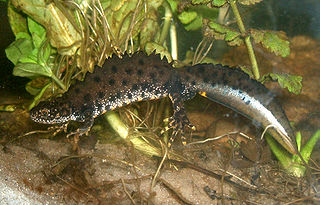
The northern crested newt, great crested newt or warty newt is a newt species native to Great Britain, northern and central continental Europe and parts of Western Siberia. It is a large newt, with females growing up to 16 cm (6.3 in) long. Its back and sides are dark brown, while the belly is yellow to orange with dark blotches. Males develop a conspicuous jagged crest on their back and tail during the breeding season.

Oryza sativa, also known as rice, is the plant species most commonly referred to in English as rice. It is the type of farmed rice whose cultivars are most common globally, and was first domesticated in the Yangtze River basin in China 13,500 to 8,200 years ago.
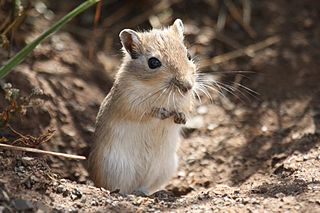
The Mongolian gerbil or Mongolian jird is a rodent belonging to the subfamily Gerbillinae. Their body size is typically 110–135 mm, with a 95–120 mm tail, and body weight 60–130 g, with adult males larger than females. The animal is used in science and research or kept as a small house pet. Their use in science dates back to the latter half of the 19th century, but they only started to be kept as pets in the English-speaking world after 1954, when they were brought to the United States. However, their use in scientific research has fallen out of favor.
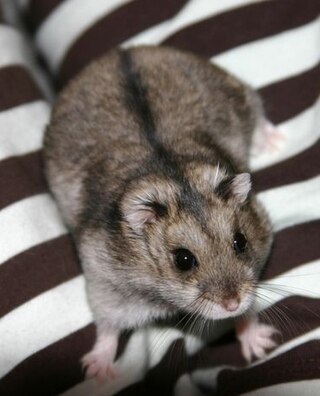
Campbell's dwarf hamster is a species of hamster in the genus Phodopus. It was given its common name by Oldfield Thomas in honor of Charles William Campbell, who collected the first specimen in Mongolia on July 1, 1902. It is distinguished from the closely related Djungarian hamster as it has smaller ears and no dark fur on its crown. Campbell's dwarf hamster typically has a narrow dorsal stripe compared to the Djungarian hamster and grey fur on the stomach. This hamster may be raised in captivity and kept as a small pet.

Phodopus, a genus of rodents in the hamster subfamily Cricetinae—a division of the larger family Cricetidae—is a lineage of small hamsters native to central Asia that display unusual adaptations to extreme temperatures. They are the only known hamsters that live in groups and, in some cases, rely on significant contributions by males to the raising of offspring. They are nocturnal and active throughout the year; they do not hibernate. Species of Phodopus, together with members of the genera Cricetulus, Allocricetulus and Tscherskia are called dwarf hamsters because of their small size relative to other hamsters.
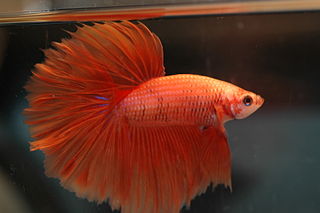
The Siamese fighting fish, commonly known as the betta, is a freshwater fish native to Southeast Asia, namely Cambodia, Laos, Myanmar, Malaysia, Indonesia, Thailand, and Vietnam. It is one of 73 species of the genus Betta, but the only one eponymously called "betta", owing to its global popularity as a pet; Betta splendens are among the most popular aquarium fish in the world, due to their diverse and colorful morphology and relatively low maintenance.

Malus sieversii is a wild apple native to the mountains of Central Asia in southern Kazakhstan. It has recently been shown to be the primary ancestor of most cultivars of the domesticated apple. It was first described as Pyrus sieversii due to its similarities with pears in 1833 by Carl Friedrich von Ledebour, a German naturalist who saw them growing in the Altai Mountains.

The masked palm civet, also called the gem-faced civet or Himalayan palm civet, is a viverrid species native to the Indian subcontinent and Southeast Asia. It has been listed as least concern on the IUCN Red List since 2008 as it occurs in many protected areas, is tolerant to some degree of habitat modification, and widely distributed with presumed large populations that are unlikely to be declining.
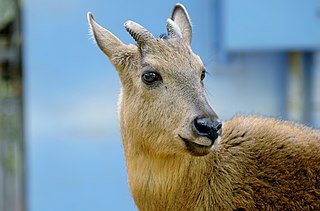
The red goral is a species of even-toed ungulate in the subfamily Caprinae in the family Bovidae. It is found in India, Tibet and Myanmar. Its natural habitats are seasonal mountainous areas 1,000 to 2,000 meters above sea level. It is threatened by habitat loss and hunting.

Szechenyi's monal-partridge, also known as buff-throated partridge or buff-throated monal-partridge, is a member of the family Phasianidae in the order Galliformes. They are endemic to western China.

Odorrana graminea, the large odorous frog, inhabits fast-flowing streams in elevated mountainous regions of Southern China and Northern Indochina. It is one of 56 species in the genus Odorrana. Male O. graminea are noted for their ultrasonic call characteristics and are one of three frog species able to detect ultrasonic frequencies, likely evolved to facilitate communication amidst noisy streams and waterfalls. Studies on O. graminea courtship vocalizations suggest female preference for increased proportion of nonlinear vocal phenomena (NLP).
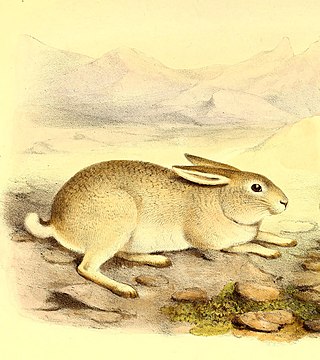
The Yarkand hare is a species of mammal in the family Leporidae. It has soft, straight, sandy brown dorsal pelage which has grayish-black stripes, and completely white ventral pelage. Endemic to China, the Yarkand hare is restricted to the Tarim Basin in Southern Xinjiang, China. It is mainly nocturnal, and forages on grass and crops. The female produces two or three litters annually, each consisting of two to five young. It is rated as near threatened on the International Union for Conservation of Nature Red List of Endangered Species and by the Red List of China's Vertebrates. However, Chinese geneticists have stated the species is "endangered" due to limited habitat and its fragmentation, and over-hunting and poaching.

The cave nectar bat, dawn bat, common dawn bat, common nectar bat or lesser dawn bat is a species of megabat within the genus Eonycteris. The scientific name of the species was first published by Dobson in 1871.

The Yangtze finless porpoise is a species of toothed whale in the family Phocoenidae, the porpoise family. It is endemic to the Yangtze River in China, making it the country's only known freshwater cetacean following the possible extinction of the baiji, a freshwater dolphin also native to the Yangtze. The Yangtze finless porpoise is considered endangered and it is estimated that only about 1,000 remain. This small toothed whale faces many of the same threats as the baiji: High human activity on the Yangtze, such as illegal fishing, pollution, boat traffic, and dam construction. Due to the rapidly declining population of the species, the Chinese government and conservation charities are working to help save it from extinction.

Phrynocephalus vlangalii, also known as the Qinghai toad-headed agama, the Ching Hai toadhead agama, the Pylzow's toadhead agama, or gecko toadhead agama, is a species of viviparous agamid lizard endemic to the Tibetan Plateau in China. This lizard lives in burrows at high elevations of 2,000 to 4,600 meters. It is also known for its aggression, especially between females during mating season since females usually only have one mate. P. vlangalii curls its tail and shows a patch on its underbelly as defense displays against conspecifics. This lizard also has a variety of gut microbiota that help perform metabolic and biological functions depending on the altitude at which the lizard lives.




















